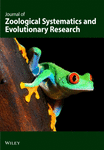A descriptive and analytical study of four neotropical drosophilid communities
Abstract
Drosophilid communities living in four different physiographical regions of the state of Rio Grande do Sul (27°/34°S; 49.7°/57.5°W), Brazil, were analysed. Ignoring cosmopolitan species, this is about the southern limit of the majority of typically neotropical Drosophila species distribution. Numerical fluctuations of the most frequent species populations from each place were investigated in relation to climatic data and trophic-resource availability. Of the four locations studied, Turvo is remarkable for being an enormous ecological reserve covered with subtropical perennially rainy forest, and for having stable weather conditions. Guaiba, on the other hand, is a more climatically unstable place, with unpredictable and more scarce resources. In Turvo, the community structure is shaped by the dominance of Drosophila willistoni and a low species diversity throughout the year. Low average niche-breadth and niche-overlap indices have also been found at feeding and breeding site levels. Guaíba showed the highest species-diversity levels and was better exploited by D. simulans, a cosmopolitan species with a well-known colonizing capacity. High niche breadth and overlap indices were characteristic for most species at this place. Results are discussed in the light of the communities' species composition and of environmental factors.




